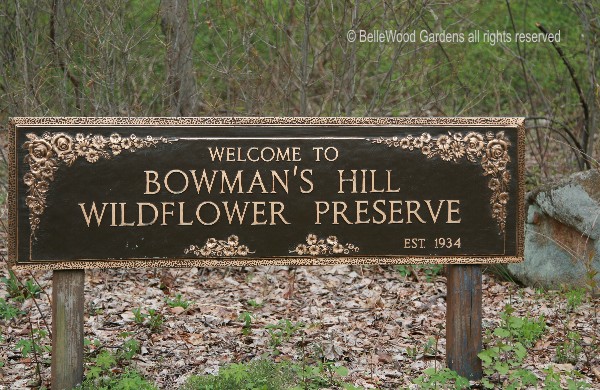
Wednesday, 20 April 2011
Bowman's Hill Wildflower Preserve
BelleWood Gardens is in New Jersey, quite near the Delaware River. I actually belong to a garden club in Pennsylvania because though in a different state it is closer than any in my home state. And the other members are very nice. Still, when I go garden gallivanting, it tends to be in New Jersey. When I received an announcement of a wildflower workshop sponsored by the Garden Club Federation of Pennsylvania it seemed too good to pass up. Admission to Bowman's Hill Wildflower Preserve, an hour-long lecture on spring wildflowers and a guided tour through the preserve, all for just $6, a pittance. Besides, while I've lectured at Bowman's Hill I haven't visited for several years. This was just the impetus I needed. So I sent in my money and waited for the day to arrive.

I drove about 30 miles down river, crossed over to the Pennsylvania side and drove just a little further.
The entire preserve is fenced against the deer, complete with driveway gates. Edge up close and they
automatically open away from your car, then close behind it. The elaborate sign identifies the preserve.
I was apparently first to arrive (the Pittsburgh contingent made the 6 hour drive yesterday, and stayed overnight) so I strolled around close to the visitor's center, looking at some flowers in a little garden, the plants for sale, and the propagation area. People began to arrive, then a few more, and eventually more than two dozen of us settled expectantly into the auditorium. The entire education department - that's Amy Hoffman - welcomed us and told us some of the history of Bowman's Hill Wildflower Preserve and showed some excellent closeup images of various Spring flowering native plants that are found on the grounds.

After which we headed out on the trails. Our group was divided in half, each with a trained naturalist,
one of the many volunteers on which the place depends. We were going on about a one mile stroll.
The walking trails are wide, well tended, and with beautiful stone steps along the steeper portions.
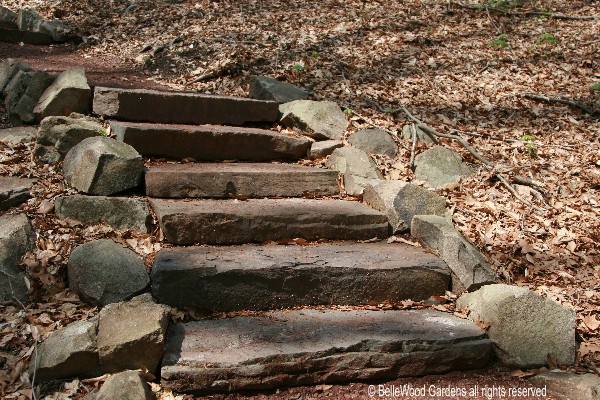
.
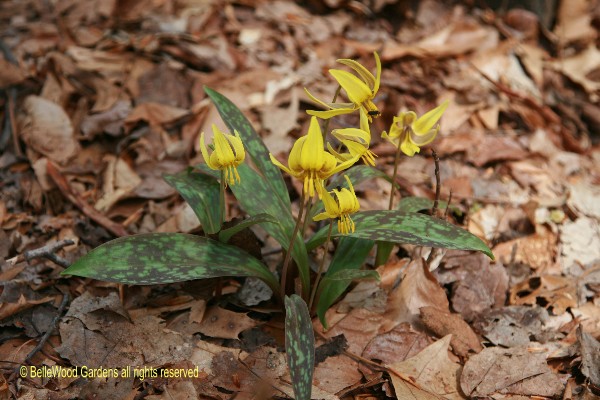
Flowers we to be seen before we even left the parking area. Just at the head of the path was this lovely
little group of dog tooth violet, Erythronium americanum. A Spring ephemeral, it grows from a small
bulb shaped rather like a dog's canine tooth. Properly fugacious, it goes dormant soon after flowering.
We walked down into a little riverine valley carpeted with Virginia bluebells, Mertensia virginica, embellished with the occasional trillium; bloodroot, Sanguinaria canadensis; some twin leaf, Jeffersonia diphylla and other charming woodland natives, progressing up and out again.
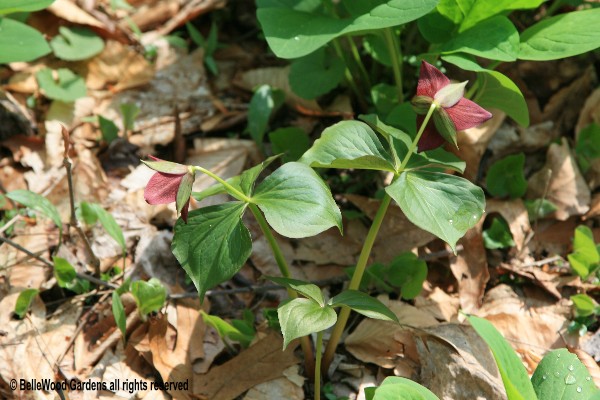
Somewhat the color of rotting meat, the oxblood red flowers of Trillium erectum, couple with a wet dog stench
attract carrion beetles for the purpose of pollination. We also saw the pristine pure white form, T. erectum album
but it was too far away from the path for me to find out if it smells any sweeter.
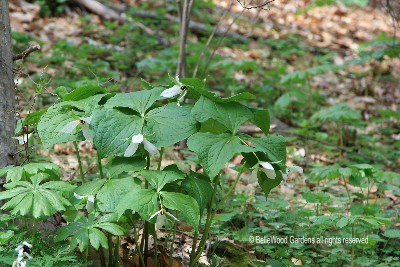
UPDATE: From Amy Hoffman, Education Coordinator at Bowman's Hill Wildflower Preserve. She wrote, "Are you open to a few comments? First is the red trillium, Trillium erectum, that we think may actually be Southern red trillium, Trillium sulcatum, due to difference in petal spreading and size. Although there can be a lot of hybridization with Trillium erectum so I could be mistaken. Then I definitely led you astray with the identification of Trillium erectum album. That is down on the Parry Trail but not the clump you were describing, which is nodding trillium, Trillium cernuum. I was confused because they both grow there."
I'm really glad to have these corrections.
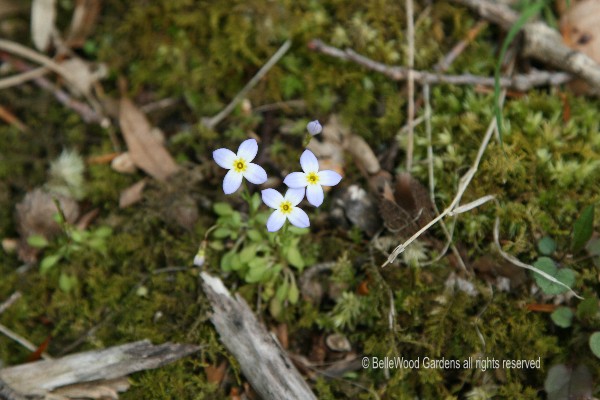
The occasional dainty group of Quaker ladies, also named bluets, Houstonia caerulea surprised me.
A number of years ago, in Connecticut, I was familiar with these as a lawn weed, not woodland dweller.
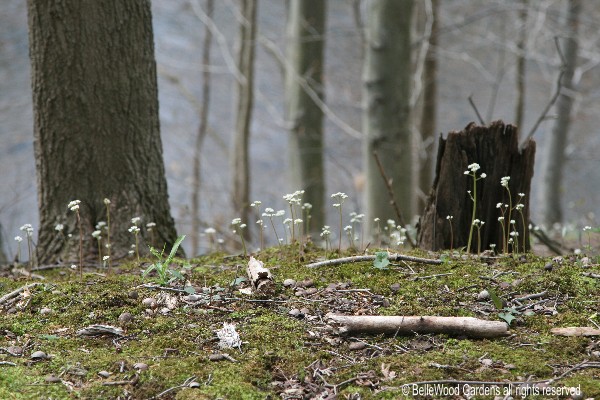
Pussytoes, an Antennaria but I don't know which one, was making an appearance, woolly gray leaves and dirty white flowers.
UPDATE: another correction from Amy - "Next is the pussytoes identification. I think that is actually early saxifrage, Saxifraga virginiensis It gets really leggy this time of year and does resemble pussytoes."
This is definately my error. Our guide had just shown us pussytoes adjacent to the path. Then as we continued on our walk I saw these at somewhat of a remove. Took the picture, could not stray off the path to check flower and foliage and just made a misidentification.
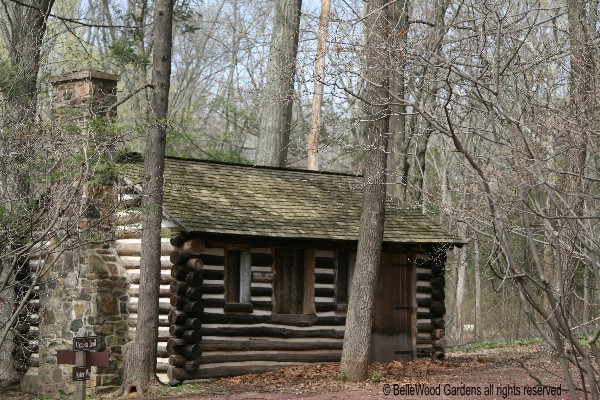
Built in the 1930s this log cabin was the first office building for Bowman's Hill Wildflower Preserve.
Made of rot-resistant chestnut logs from trees which died in the blight that extirpated the species
it was moved to this location when the current visitors center was built. What a charming building.
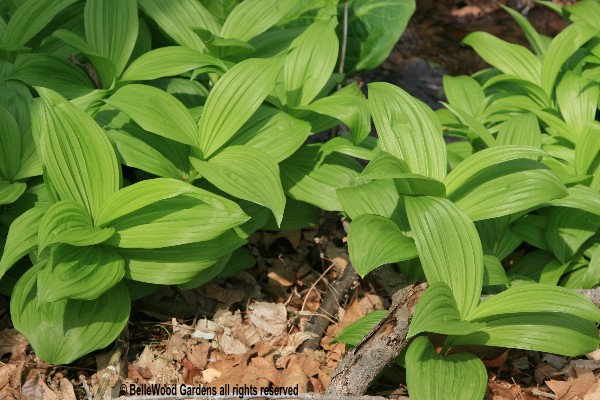
As we swung around, following the trail back to the visitors center we reached a swampy area.
I'm very fond of the magnificently pleated leaves of false hellebore, Veratrum viride. Alas,
it is not a plant that's happy in cultivation, preferring life on its own, in the wild to that in a garden.
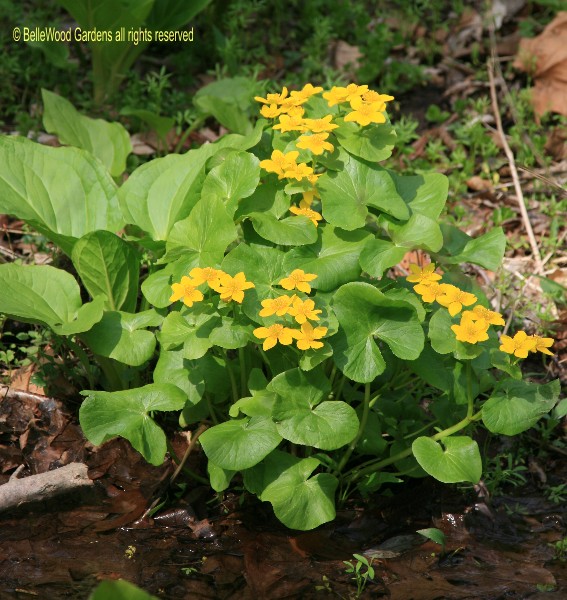
The swampy area is named for this more obliging wetland-loving plant, marsh marigold. For those
intimidated by Latin names, keep in mind that palustris, the species name of Caltha palustris
means "of marshes". A good clue when you're looking for plants to grow in wet places.
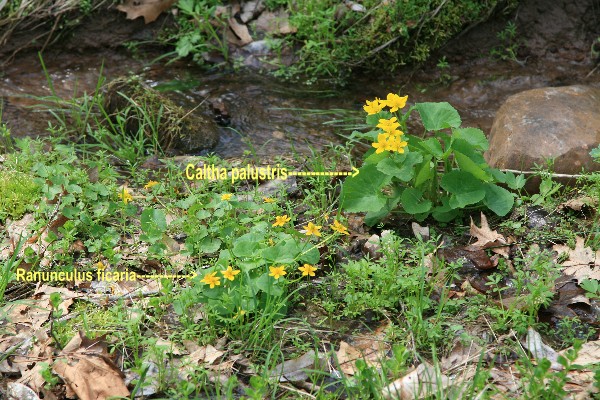
Both of these plants have cheerful yellow flowers at this time of year. One, found in marshes, fens, ditches
and wet woodland in temperate regions of the Northern Hemisphere is welcomed in gardens. The other
is an absolute thug with territorial ambitions. Which is which? Marsh marigold, king cups, molly-blobs
provide forest green leaves and rich golden flowers when grass is sere and brown and trees still bare.
Frog-bit, lesser celandine, Ranunculus ficaria, is one of the worst, difficult to eradicate weeds. Little tubers
break off, remain in the soil, float downstream to lodge and grow anew. I dig and bag, complete with soil,
then put in the garbage to be interred in a landfill where they cannot escape to grow and thrive and spread.
UPDATE: Another comment from Amy - "Thanks for including info about invasive plants, it so important to teach people about the different species that we're battling! In the picture that you labeled, that appears to be just a shorter clump of marsh marigold. I'm looking at the flowers with 5 thicker petals and more of a clumping habit. The lesser celandine is actually right underneath the word "marsh marigold" with its very low foliage and flowers with 9 slender petals."

Just to be sure everyone appreciates the differences here's a closeup of lesser celandine, Ranunculus ficaria
How fortunate that today's outing offered us a Spring display of native plants (of which the frog-bit is not one.)